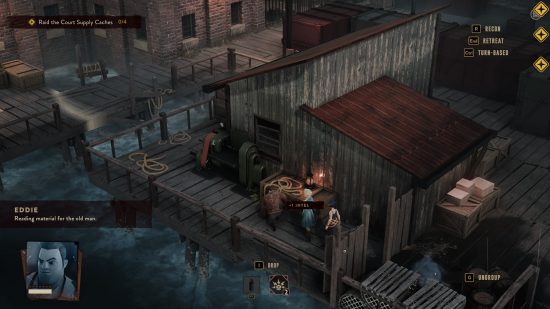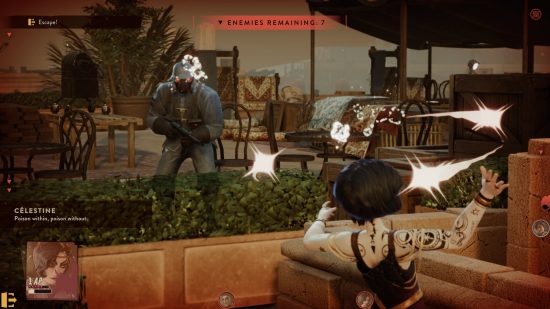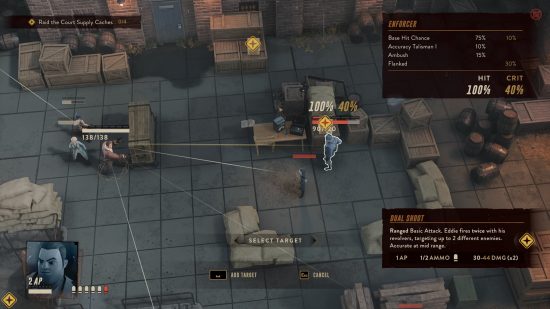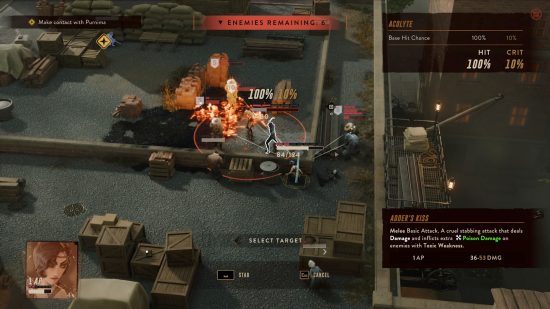Our Verdict
The Lamplighters League attempts to deviate from tradition, promoting creativity over power, but ultimately falls short. However, its simplicity puts it into the more approachable realms of turn-based tactical games and is a great choice for anyone looking to try the genre for the first time.
You got moxie, kid. Better people than you have been and gone, but you’ve got spunk in spades, and you’ll need it if you wanna make it as a Lamplighter. You’ll find yourself sneaking through docklands to take out knife-wielding masked fanatics and exploding oil barrels in dense jungle. Under its fun alt-1930s theming, The Lamplighters League is a fairly standard turn-based tactics game akin to XCOM, pitting a group of misfits against several groups of fascists (and a handful of supernatural beings) in an effort to save the world.
The game follows the turn-based tactics mold, with a few slight twists. You have your squad of three agents, an enclosed mission area, and a whole lot of enemies. Where Lamplighters changes the formula on old favorites of the genre like XCOM is the infiltration part of a mission: before the fighting starts, you’re able to walk around in real-time, scoping the area out, ideally setting up the perfect ambush, or, in theory, completing objectives without fighting at all.
Once the fighting begins, everything flips from real-time to turn-based. And while the infiltration portion of a mission is an intriguing idea, in reality it feels a little unwieldy. Enemies perform patrols, they have vision cones, and while there are occasions when you can do work without being detected, I found a lot of the time I could only venture so far without having to engage the enemy in some way. This could, of course, be user error, but no matter how hard I tried to stay hidden, the mission always devolved into a bit of a mess – and not always the fun kind.
The enemy AI seems a little confused sometimes, and this only serves to exacerbate the messy nature of fights. As soon as you’re discovered – or as soon as you launch your cunning ambush – the opposing forces tend to clump together and barrel to your agents en masse, leaving your agents to duke it out in a more straightforward way than I would have liked.
There is a way to grind down your opponents that isn’t just beating them to a bloody pulp, and that’s stress. Stress is accrued when anyone – even your own agents – comes under fire, and if their stress level reaches breaking point, the actions they can take are reduced, and they are susceptible to a ‘finishing move.’ There are Lamplighter agents who take advantage of this mechanic, able to further stress enemies out, but it’s nearly always more efficient to riddle them with holes.
Your team, if you want to call it that, is a rag-tag bunch of weirdos plucked from the four corners of the earth. We’re told that the original Lamplighters all met rather grizzly ends, so it’s definitely more of a ‘needs must’ kind of situation. Each of your agents has a very specific set of skills and fulfills a different role in combat, and you can select your team before dropping into a mission. My main trio consisted of a cocky, gun-toting American, a mysterious dagger-wielding femme fatale, and a mob enforcer who has a penchant for pain. The dangerous nature of our work means that this is by no means the team that tackles every mission, but they’ve been my go-to group. Generally, I like the characters, who all feel ripped from the pages of a ridiculous 30s pulp novel – the kind of thing with a title in bright yellow text and a woman with a dangerously ripped shirt on the cover – and are charming as a result.
I use Fedir, the mob enforcer, as my de facto tank, rushing into groups of enemies and causing as much havoc as he can. Eddie the gunfighter stays back and deals damage while trying to stay out of the firing line himself, and Celestine, the assassin, uses her mind control abilities (a thing she has) to turn her enemies into allies. Finding a balance between damage and sustainability is key for these small squads, as the proto-Nazis can quickly overwhelm if you’re skewed to one end of the spectrum.
The world is in danger, of course, and it looks like the new Lamplighters are probably the only ones who can save it. There are various MacGuffins littered around the world map, which must be collected post-haste – the only issue being the other more nefarious factions who are after the same trinkets for their own, decidedly evil, purposes. Like House Strum, who has somehow harnessed the power of ancient Egypt, and has a small army of exploding mummies at their disposal. Each of the enemy factions is represented on the world map with a dial, and each time you complete a mission that isn’t a direct attack on your enemies, the faction doomsday clocks tick on. If a dial manages to complete a rotation, you get the chance at a mission to defeat them – but it’s an extra difficult one.
It’s an intricate juggling act, as the missions are also your main way of gaining resources to improve your Lamplighter agents. Even though the Lamplighters are led by a man who owns his own island, you’re still required to fund your own progression. You can build equipment that applies specific buffs, spend skill points on improving your agent’s abilities, or simply purchase a bunch of frag grenades to throw about willy-nilly. You must decide with each turn whether you want to push back your enemies, attempt to recruit another member for your cool club, or run a recce for more valuables. It’s good in the sense that it keeps you on your toes, as every step you take could have an effect later down the road.
It’s especially important that you manage your time well and ensure you’re gathering enough resources, as improving your agents by spending points in their skill trees has a dramatic effect on their combat viability, with seemingly useless team members becoming certified killers the later you get into a campaign. My sniper, Purnima, could barely damage one enemy per turn when she joined the Lamplighters, but with some upgrades, she’s now able to blind enemies, turn invisible, and bounce her bullets to hit several people at once.
But even as you improve your team, The Lamplighters League does a great job of never letting you feel in control; there’s always someone to save, a plot to thwart, or an area to investigate. Never getting into your comfort zone really drills home the underdog feeling of the Lamplighters themselves, and the overwhelming odds you face. The stakes grow higher with each turn, too, with your agents taking longer to recover should they fall in battle, forcing you to mix things up perhaps more than you’d like. To every action, there is an equal and opposite reaction, and while it may feel like you’re playing catch-up a lot of the time, finally toppling your enemies is exceptionally satisfying.
I found it almost impossible to peg back all of my enemies equally in the main campaign, with one always getting a foothold, so I found that the real race to the finish was ensuring my own power was enough to defeat them once the last chance mission came around. Keeping my agents healthy was a particular challenge, but prioritizing the acquisition of new blood meant that I nearly always had a powerful squad to hand. Initially, I plowed all of my ability points into one agent, but after they were injured on a mission, I was left severely short-handed.
Still, I never felt attached to my agents like I would in a run of XCOM, and their stories never really grabbed me. Most of the dialogue is delivered from a near-static screen back in your hideout; cliche-ridden, albeit setting-appropriate, chatter. For a veteran of the genre, The Lamplighters League is a fun if slightly disengaging ride, and you might be better looking towards Mimimi’s Shadow Gambit instead if you want a tactical game that poses a true challenge and rewards player creativity.
The combat does encourage a degree of creativity and improvisation, with environmental factors playing a part if you so choose – oil barrels to set alight, generators to shock your enemies, etc. – but they still nearly always end up in a straight-up brawl, beating each other until one side relents. Because of the simplistic, almost brute-force nature of these fights, it does put The Lamplighters League into the more accessible section of turn-based tactical games and is perfect for anyone approaching this genre for the first time, but for those who are looking for something new, you may be left a little disappointed.




